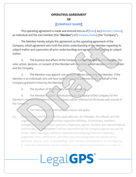Succession Provisions in LLC Operating Agreements: Drafting Tips for 2025
The statistics are sobering: only 30% of family businesses survive into the second generation, and just 12% make it to the third. Behind these...
8 min read
LegalGPS : Oct. 4, 2025
Planning for what happens to your LLC when you're no longer running it might seem premature, but it's one of the most critical decisions you'll make as a business owner. Without a clear succession plan, your carefully built company could face legal battles, operational chaos, or even dissolution when you least expect it.


Legal GPS Pro
Protect your business with our complete legal subscription service, designed by top startup attorneys.
An LLC ownership succession plan provides a roadmap for transferring ownership and control of your business. Whether you're planning retirement, considering a sale, or simply want to protect your business from unexpected events, having this plan in place protects both your investment and your team's future.
An LLC ownership succession plan is a comprehensive document that outlines how ownership interests and management responsibilities will transfer when current owners leave the business. Think of it as your business's inheritance plan – it determines who gets what, when they get it, and how the transition will happen.
Unlike corporations with standard stock structures, LLCs have membership interests that can be more complex to transfer. Your succession plan addresses these unique challenges while ensuring business continuity. The plan typically covers ownership percentages, management roles, valuation methods, and trigger events that activate the succession process.
Most entrepreneurs assume their operating agreement covers succession planning, but standard templates rarely address the specific scenarios your business might face. A dedicated succession plan fills these gaps with detailed procedures and clear expectations for all parties involved.
Your succession plan should specify exactly what happens during different trigger events. These might include voluntary departure, retirement, disability, death, or removal for cause. Each scenario requires different procedures and timelines.
The plan also establishes how membership interests will be valued and transferred. This includes appraisal methods, payment terms, and restrictions on who can become new members. Without these details, disputes are almost inevitable.

LLC Ownership Succession Plan Agreement
Use our LLC Ownership Succession Plan Agreement Template to prepare for smooth transitions. Practical and adaptable for long-term business planning.
Trusted by 1,000+ businesses to safeguard their LLCs.
Many business owners delay succession planning because they're focused on growth and daily operations. However, waiting creates unnecessary risks that could destroy everything you've built. Unexpected events happen to businesses of all sizes, and preparation makes the difference between survival and collapse.
Consider the statistics: over 70% of family businesses fail to survive to the second generation, often due to poor succession planning. Even partnerships between unrelated parties face similar challenges when owners leave without clear transition procedures.
Sarah and Mike founded a software development LLC that grew to $2 million in annual revenue over five years. When Mike suddenly decided to leave for a corporate job, they realized their operating agreement only mentioned a "buyout" without specifying terms.
The dispute over Mike's membership interest value dragged on for eight months. During this time, clients grew nervous about the company's stability, two key employees left for competitors, and Sarah had to use personal funds to keep operations running. By the time they reached a settlement, the business had lost 40% of its client base.
This situation could have been avoided with a succession plan that included clear valuation methods, payment terms, and transition procedures. The cost of creating the plan would have been a fraction of the losses they ultimately suffered.
A comprehensive succession plan addresses both the technical aspects of ownership transfer and the practical realities of running your business during transitions. The most important component is clearly defined trigger events that activate different parts of your plan.
Your plan should specify voluntary departure, involuntary removal, disability, death, and retirement as distinct trigger events. Each requires different procedures, timelines, and considerations. For example, voluntary departure might allow for a longer transition period, while death requires immediate action to maintain business continuity.
Establishing how you'll value membership interests prevents disputes and ensures fair treatment for all parties. Your plan should specify the appraisal method, who conducts valuations, and when they occur. Common methods include asset-based valuation, earnings multiples, or professional appraisals.
Payment terms are equally important. Will the departing member receive a lump sum, installment payments, or a combination? How will you handle situations where the business lacks sufficient cash for immediate payment? These details prevent financial strain on the continuing business.
Choose a valuation method that's appropriate for your industry and business model. Service businesses might use revenue multiples, while asset-heavy companies might prefer book value approaches. Whatever method you choose, make sure it's objective and can be consistently applied. Consider including provisions for professional appraisals in high-value situations or disputes.
The most expensive mistake business owners make is assuming their operating agreement provides sufficient succession planning. Standard templates rarely address the specific circumstances your business might face, leaving gaps that become costly problems during actual transitions.
Another common error is failing to update succession plans as the business grows and changes. A plan that worked for a two-person startup might be completely inadequate for a company with multiple locations and dozens of employees. Regular reviews and updates are essential for maintaining effective protection.
The Rodriguez family owned a successful restaurant chain with three locations. When patriarch Carlos decided to retire, he had already spent two years preparing his daughter Maria to take over operations while his son Luis would handle finances.
Their succession plan included specific timelines for the transition, training requirements for the new leaders, and payment terms for Carlos's retirement buyout. Most importantly, they had identified and addressed potential family conflicts before they became problems.
The transition took place over six months, with Carlos gradually reducing his involvement while Maria and Luis assumed full responsibility. The business continued growing throughout the transition, and family relationships remained strong because everyone understood their roles and expectations.
Many business owners discuss succession plans verbally but fail to document them properly. Without written agreements, memories fade, circumstances change, and disputes become inevitable. Every aspect of your succession plan must be clearly documented and legally binding.
The documentation should be comprehensive enough that someone unfamiliar with your business could understand and implement the procedures. This includes step-by-step processes, contact information for key advisors, and copies of all necessary forms and agreements.
Start by conducting a comprehensive assessment of your current situation. This includes reviewing your operating agreement, analyzing your business structure, and identifying all stakeholders who would be affected by ownership changes. Understanding where you are today provides the foundation for planning where you need to go.
Next, identify all possible succession scenarios your business might face. Consider both planned transitions like retirement and unplanned events like death or disability. Each scenario should have specific procedures that address the unique challenges it presents.

Clearly articulate what you want to achieve through your succession plan. Are you primarily concerned with maximizing value for departing owners, ensuring business continuity, or maintaining family control? Different goals require different strategies and provisions.
Your goals should also consider the interests of remaining members, employees, and customers. A good succession plan balances the needs of all stakeholders while protecting the business's long-term viability.
Tom and Jennifer built a successful marketing agency over eight years. When personal conflicts led Jennifer to want out, they discovered their operating agreement only stated that departing members would receive "fair market value" for their interests.
Tom believed Jennifer's 50% stake was worth $150,000 based on the company's asset value. Jennifer argued it was worth $400,000 based on earnings potential. Without clear valuation criteria, they ended up in litigation that cost both parties over $75,000 in legal fees.
The court ultimately ordered a professional appraisal that valued Jennifer's interest at $275,000. However, the legal battle damaged their professional reputations and client relationships, reducing the business's actual value significantly below the appraised amount.
Your succession plan must comply with both state LLC laws and the terms of your existing operating agreement. Some states have specific requirements for membership interest transfers, while others provide more flexibility. Understanding these requirements ensures your plan will be legally enforceable when needed.
The documentation package typically includes amendments to your operating agreement, buy-sell agreements, and supporting documents like valuation procedures and payment schedules. Each document should be reviewed by qualified legal counsel to ensure compliance and enforceability.
A comprehensive succession plan requires multiple interconnected documents. The core document is typically a buy-sell agreement that specifies trigger events, valuation methods, and transfer procedures. This agreement should be designed to work seamlessly with your existing operating agreement.
Supporting documents might include valuation worksheets, payment schedule templates, and notification procedures for implementing the plan. Having all necessary forms and procedures prepared in advance eliminates delays and confusion during actual succession events.
Verbal agreements and informal understandings have no place in succession planning. Every aspect of your plan must be clearly documented, signed by all parties, and regularly updated. This includes not just the main agreements but also supporting procedures, contact lists, and implementation checklists. When succession events occur, emotions run high and memories become unreliable – detailed documentation provides objective guidance.
Service-based businesses face unique succession challenges because much of their value depends on relationships and expertise that might not transfer easily. Your plan should address client retention, key employee retention, and knowledge transfer to ensure business continuity.
Manufacturing and retail businesses typically have more tangible assets but face different challenges around inventory management, supplier relationships, and operational expertise. These businesses need succession plans that address both asset transfer and operational continuity.
Dr. Williams built a successful family practice over 20 years and wanted to retire by age 65. Three years before his planned retirement, he began implementing his succession plan by bringing in Dr. Chen as a junior partner with a path to eventual ownership.
The succession plan included a five-year timeline with Dr. Chen gradually increasing his ownership percentage while Dr. Williams reduced his patient load. Clear milestones determined when ownership transfers would occur and how they would be valued.
The transition preserved patient relationships, maintained staff continuity, and provided Dr. Williams with a steady retirement income. Most importantly, the practice continued serving the community without interruption because the succession plan addressed both business and patient care considerations.
Effective succession planning requires preparing for various possible futures. Your business might be sold to competitors, transferred to family members, sold to employees, or liquidated entirely. Each scenario requires different procedures and considerations.
Consider creating contingency plans for situations where your primary succession strategy doesn't work out. For example, if family members aren't interested in taking over the business, what's your backup plan? Having alternatives prevents hasty decisions during stressful times.
Succession planning has significant tax implications that can dramatically affect the value received by departing members and the cost to continuing owners. Different transfer methods trigger different tax treatments, and timing can significantly impact overall costs.
Work with qualified tax professionals to structure your succession plan in the most tax-efficient manner possible. This might involve installment sales, tax-deferred exchanges, or other strategies that minimize the tax burden for all parties.
Peterson Manufacturing faced a crisis when founder Jim Peterson had a heart attack at age 58. Fortunately, their succession plan included provisions for temporary incapacity and long-term disability situations.
The plan immediately activated management procedures that allowed operations to continue under the leadership of longtime general manager Katie Sullivan. Meanwhile, the plan's valuation procedures enabled Jim's family to understand their options for his ownership interest.
After six months of recovery, Jim decided to accelerate his retirement plans. The succession plan's sale procedures allowed for an orderly transition to Katie, who had secured financing to purchase Jim's interest. The business maintained its workforce, supplier relationships, and customer base throughout the transition.
Succession planning involves complex legal, tax, and financial considerations that require professional expertise. The cost of qualified advisors is minimal compared to the potential losses from inadequate planning or implementation mistakes.
Your advisory team should include an attorney experienced in business law, a CPA familiar with business taxation, and potentially a business valuator for complex situations. Each professional brings specialized knowledge that's essential for creating and implementing effective succession plans.
Don't create a succession plan based on only one possible future. Business circumstances change, family situations evolve, and market conditions shift. Build flexibility into your plan that allows for different exit strategies and timing. Include provisions for partial sales, gradual transitions, and complete buyouts. This flexibility ensures your plan remains useful regardless of how your situation changes over time.
The most important step in succession planning is getting started. Even a basic plan provides more protection than no plan at all, and you can refine and improve your plan over time as your business evolves.
Begin by reviewing your current operating agreement and identifying gaps in succession coverage. Then prioritize the most likely scenarios your business might face and start developing procedures for those situations.
Legal GPS offers comprehensive templates and resources for LLC succession planning that can help you get started quickly and cost-effectively. Our Pro subscription includes step-by-step guidance, customizable documents, and ongoing support to ensure your succession plan meets your business's specific needs.
Remember that succession planning is not a one-time event but an ongoing process. Regular reviews and updates ensure your plan remains current and effective as your business grows and changes. The time you invest in succession planning today protects everything you've worked to build and provides peace of mind for you and your stakeholders.

Legal GPS Pro
Protect your business with our complete legal subscription service, designed by top startup attorneys.
|
Premium Template
Single-use Template |
Legal GPS Pro
Unlimited Access, Best Value |
|
|
| Choose Template | Learn More |
| Trusted by 1000+ businesses | |
Table of Contents

The statistics are sobering: only 30% of family businesses survive into the second generation, and just 12% make it to the third. Behind these...

An LLC’s operating agreement serves as the foundation for governing the business, defining ownership rights, and outlining key decision-making...

Many LLC owners focus on day-to-day operations but fail to plan for the future of their business when an owner retires, leaves, or becomes unable to...